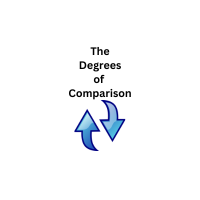The Degrees of Comparison of Adverbs

The degrees of comparison of Adverbs:
Positive degree:
The simple form of the adverb without any comparison.
Example: She runs fast.
Comparative degree:
Used to compare two actions, showing a higher or lower degree of the adverb.
Example: She runs faster than him.
Superlative degree:
Used to compare one action to all others in a group, showing the highest or lowest degree of the adverb. Example: She runs (the) fastest in the team.
To form the comparative degree of most adverbs, add more before the adverb (e.g., more quickly).
For the superlative degree, add most before the adverb (e.g., most quickly).
However, some adverbs have irregular forms (e.g., well – better – best, badly – worse – worst), so it’s essential to be familiar with irregular adverbs as well.
The table containing all three forms (positive, comparative, and superlative) of the adverbs
| Adverb | Positive Form | Comparative Form | Superlative Form |
| fast | fast | faster | fastest |
| hard | hard | harder | hardest |
| late | late | later | latest |
| soon | soon | sooner | soonest |
| early | early | earlier | earliest |
Now, you have all three forms for each adverb, which will allow you to make comparisons in sentences effectively.
A table showing the comparison degrees of adverbs formed from adjectives by adding the -ly suffix.
We use more before the comparative form and most before the superlative form of these adverbs:
| Adjective | Adverb (with -ly suffix) | Comparative Form | Superlative Form |
| quick | quickly | more quickly | most quickly |
| slow | slowly | more slowly | most slowly |
| careful | carefully | more carefully | most carefully |
| beautiful | beautifully | more beautifully | most beautifully |
| easy | easily | more easily | most easily |
| noisy | noisily | more noisily | most noisily |
| happy | happily | more happily | most happily |
| serious | seriously | more seriously | most seriously |
| quiet | quietly | more quietly | most quietly |
| angry | angrily | more angrily | most angrily |
Here are the degrees of comparison for the adverbs often, quickly, and slowly:
| Adverb | Positive Form | Comparative Form | Superlative Form |
| often | often | more often | most often |
| quickly | quickly | more quickly | most quickly |
| slowly | slowly | more slowly | most slowly |
Here’s the table with the degrees of comparison for the adverbs well, badly, much, little, and far:
| Adverb | Positive Form | Comparative Form | Superlative Form |
| well | well | better | best |
| badly | badly | worse | worst |
| much | much | more | most |
| little | little | less | least |
| far | far | farther/further* | farthest/furthest* |
Note: Farther and farthest are typically used when referring to physical distance, whereas further and furthest are more commonly used in non-physical contexts.
However, the distinction between these two forms is not strictly observed in all varieties of English, and they are often used interchangeably.
Now, you have all the forms for each adverb in a table, allowing you to compare actions or properties with varying degrees of intensity or quantity.
click here The Degrees of Comparison of Adverbs
click here The Forms of Adverbs
click here What is an Adverb?
click here Degrees of Comparison of the Adjectives